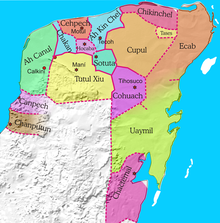Ekab
ECAC ( ECAC , Ek'Aab ) was a principality ( Mayathan : kuchkabal ) of Maya on the Yucatan during the Postclassic that until the time of the Conquest had inventory.
Description and history
The Ekab jurisdiction borrowed its name from a place of the same name on the northeastern tip of Yucatán, which is said to have been the seat of a Halach Huinik at the same time . Most historians attribute Ekab to the centrally ruled principalities of the Yucatán, similar to Hocabá or Ah Kin Chel . However, no name of a ruler has been passed down.
Ekab borders in the northwest on Chikinchel, Tases and Cupul , in the southwest the border is particularly unsecured, it is commonly assumed that there was a border with Cochuah in the south . However, since the eastern extent of the sphere of influence of Chupul and Cochuah is not clearly secured, it can only be assumed that there was a southern border with Uaymil.
In addition to Cobá , which very probably belonged to Ekab, there were a number of coastal towns such as El Rey , El Meco , Polé , Xel Há , Zama , Tancah and Muyil , which were part of a very flourishing coastal trade network until the Spanish era. Polé, due to its location opposite Cozumels , where a central pilgrimage site of the goddess Ix Chel was located, played a separate role. From there the pilgrims came to the island. El Melco, which was across from Isla Mujeres , where there was also a local shrine to the goddess Ix Chel, may have played a similar role in a weakened manner. In Xel Há, two parts of the settlement were connected by a sacbé .
El Rey archaeological site
The five-tier pyramid in El Meco is the largest Mayan building in the region at 17 m high.
Temple ruins in Polé
Temple building in Xel Ha
Zama archaeological site
Xlahpak Temple in Muyil
In 1511 13 Spanish shipwrecked people landed in Ekab, of which only Gerónimo de Aguilar and Gonzalo Guerrero were still alive in 1519 . The former joined the Konquista , the latter the Maya, with whom he rose in Ch'aak Temal to Nacom and later to Kaziken . He married into the local ruling family and is still venerated today as the "father of the mestizos".
Even before the uprisings against colonization and Christianization, Ekab initially resisted the Spanish. As early as 1517, Córdoba encountered military resistance near Catoche . Grijalva also suffered losses on individual trips ashore the following year. In 1527 Montejo landed in front of Xel Há and was able to found the settlement Salamanca de Xelha without major resistance . From there he pushed into the northern interior of the country, but was involved in bloody battles near Chikinchel, which he was able to win. Salamanca de Xelha was abandoned and founded a few kilometers north of Salamanca de Xamanha in 1528 . He then took garrison for two months in Conil, the then largest city in Ekab. The conquista now first shifted to the west of the Yucatán, where the Spaniards were able to win over influential Mayan princes with the Xiu and Pech . In the years 1542–1547, the final phase of the conquest of the Yucatán, the Spanish took bloody measures in the east. By 1550 or at the end of the 16th century, Ekab's Caribbean coast was largely depopulated and most of the places were deserted. An exception was Polé, now Xcaret, which remained continuously inhabited. In addition, only Cachi, Conil, Ecab and Zama were named as small villages in the church directory of 1582. Ekab now forms the northernmost part of the state of Quintana Roo .
literature
- Nikolai Grube (Ed.): Maya. God kings in the rainforest . Könemann-Verlag, Cologne 2000, pp. 341-350, 375-378
- Diego de Landa : Yucatan Before and After the Conquest , 2012, p. 143ff (online preview)
- Ralph L. Roys : The Political Geography of the Yucatan Maya. Washington 1957, pp. 143–153 (online preview)






